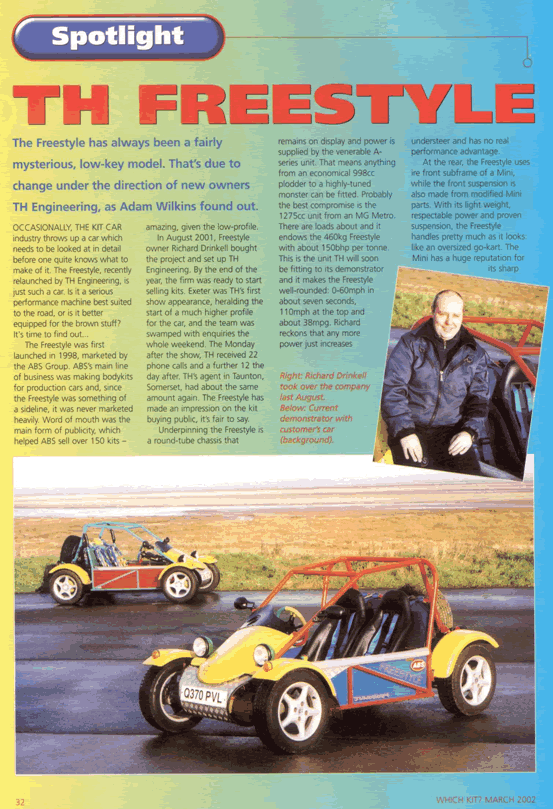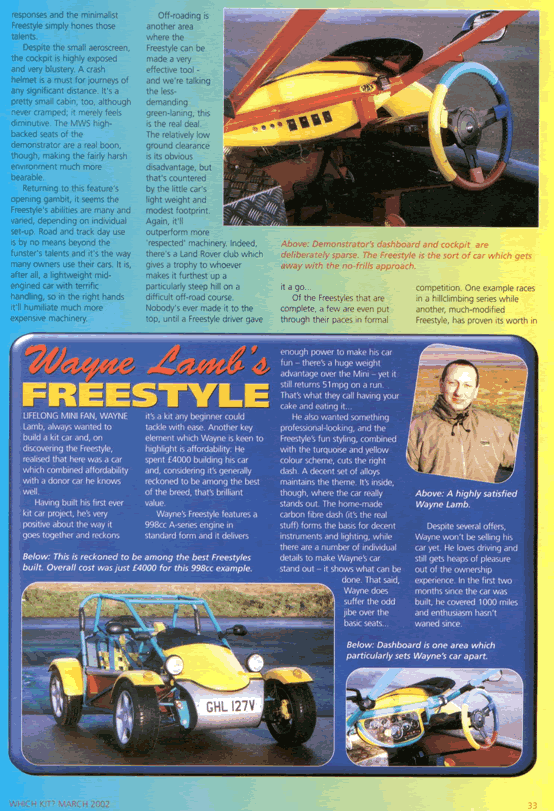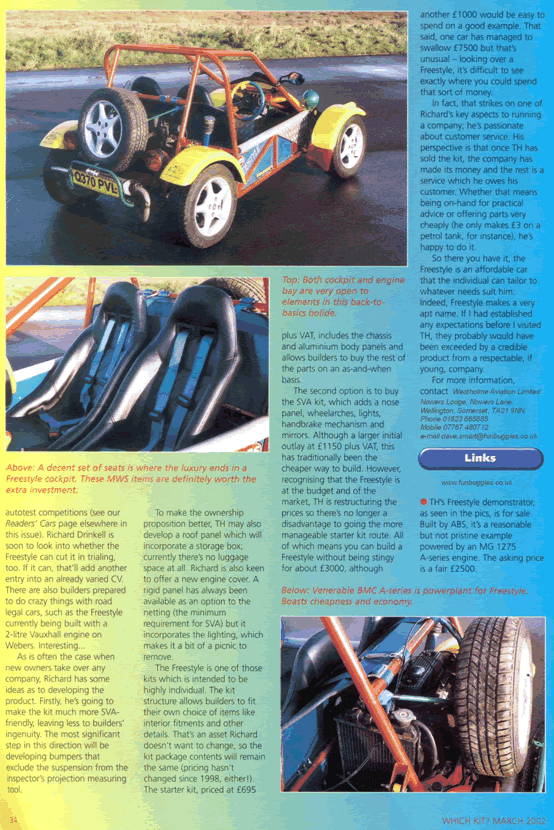|
The article below is about the funbuggies Freestyle before it was owned by Dave Smart, In Fact this article was what first got me interested in the Freestyle. I have scanned a copy of the whole article and is below just click on the thumbnail to read but because my copy is not great I am writing the article out in full for you and this way you should work it out. Thank You Which KIt Magazine!!! TH FREESTYLE The Freestyle has always been a fairly mysterious, low-key model. That’s due to the change under the direction of new owners TH Engineering, as Adam Wilkins found out. OCCASIONALLY, THE KIT CAR industry throws up a car which needs to be looked at in detail before one can quite knows what to make of it. The Freestyle, recently re launched by TH Engineering, is just such a car. Is it a serious performance machine best suited to the road, or is it better equipped for the brown stuff? It’s time to find out…. The Freestyle was first launched in 1998, marketed by the ABS Group. ABS’s main line of business was making body kits for production cars, and since the freestyle was something of a sideline, it was never marketed heavily. Word of mouth was the main form of publicity, which helped ABS sell over 150 kits amazingly, given the low profile. In august 2001, Freestyle owner Richard Drinkell bought the project and set up TH Engineering. By the end of the year, the firm was ready to start selling kits. Exeter was TH’s first show appearance, heralding the start of a much higher profile for the car, and the team was swamped with enquiries the whole weekend. The Monday after the show, TH received 22 phone calls and a further 12 the day after, TH’s agent in Taunton Somerset, had about the same again. The Freestyle has made an impression on the kit buying public, its fair to say. Underpinning the Freestyle is a round-tube chassis that remains on display and power is supplied by the vulnerable A-Series unit. That means anything from the economical 998cc plodder to a highly-tuned monster can be fitted. Probably the best compromise is the 1275cc unit from an MG Metro. There are loads about and it endows the 460kg Freestyle with about 150bhp per tonne. This is the unit TH will soon be fitting to its demonstrator and it makes the Freestyle well rounded 0-60mph in about 7 seconds, 110mph at the top and about 38mpg, Richard reckons that any more power just increases under steer and has no real performance advantage. At the rear, the Freestyle uses the front subframe of a Mini, while the front the front suspension is also made from modified Mini parts, with its light weight respectable power and proven suspension, the Freestyle handles much as it looks, like an oversized go-kart. The Mini has a huge reputation for its sharp responses and the minimalist Freestyle simply hones those talents. Despite the small aeroscreen, the cockpit is highly exposed and very blustery. A crash helmet is a must for journeys of significant distance, its a pretty small cabin too, although never cramped, it merely feels diminutive. The MWS high backed seats of the demonstrator are a real boon, though making the fairly harsh environment much more bearable. Returning to this features opening gambit, it seems the Freestyle’s abilities are many and varied depending on individual setup. Road and track day use is by no means beyond the funstars talents and it’s the way many owners use their cars. It is after all, a lightweight mid engined car with terrific handling, so in the right hands it will humiliate much more expensive machinery. Off-roading is another area where the Freestyle can be made a very effective tool and we’re talking the less demanding green laning, this is the real deal. The relatively low ground clearance is its obvious disadvantage, but that’s countered by the little car’s light weight and modest footprint. Again, it’ll outperform more respected machinery. indeed there’s a Land Rover club which gives a trophy to whoever makes it furthest up a particularly steep hill on a difficult off-road course. Nobody’s ever made it to the top, until a Freestyle driver gave it a go… Of the Freestyle’s that are complete, a few are even put through their paces in formal competition. One example races in a hill climbing series while another, much-modified Freestyle, has proven its worth in autotest competitions. Richard Drinkell is soon to look into whether the Freestyle can cut it at trialing too. If it can, that’ll add another entry into an already varied CV. There are also builders prepared to do crazy things with road legal cars, such as the Freestyle currently being built with a 2-litre Vauxhall engine on Webers. Interesting…. As often the case when new owners take over any company, Richard has some ideas as to developing the product. Firstly, he’s going to make the kit much more SVA friendly. Leaving less to the builders ingenuity. The most significant step in this direction will be developing bumpers that exclude the suspension from the inspector’s projection measuring tool. To make the ownership proposition better, TH may also develop a roof panel which will incorporate a storage box. Currently there is no luggage space at all. Richard is also keen to offer a new engine cover. A rigid panel has always been available bas an option to the netting (the minimum requirement for the SVA) but it incorporates the lighting which makes it a bit of a picnic to remove. The Freestyle is on of those kits which is intended to be highly individual. The kit structure allows builders to fit their own choice of items like interior fitments and other details. That’s an asset Richard doesn’t want to change, so the kit package contents will remain the same (pricing hasn’t changed since 1998, either!!) The starter kit priced at £695 plus VAT, includes the chassis and alluminium body panels and allows builders to buy the rest of the parts on an as-and-when basis. The second option is to buy the SVA kit, which adds a nose panel, wheel arches, lights, handbrake mechanism and mirrors. Although a larger initial outlay at £1150 plus VAT, this has traditionally been the cheaper way to build. However, recognising that the Freestyle is at the budget end of the market, TH is restructuring the prices so there’s no longer a disadvantage to going the more manageable starter kit route. All of which means you can build a Freestyle without being stingy for about £3000, although another £1000 would be easy to spend on a good example. That said, one car has managed to swallow £7500 but that’s unusual – looking over a Freestyle its difficult to see where you could spend that sort of money. In fact, that strikes on one of Richards key aspects to running a company, he’s passionate about customer service. His perspective is that once TH sold the kit, the company has made its money and the rest is a service which he owes his customer, whether that means being on-hand for practical advice or offering parts very cheaply, he only makes £3 on a petrol tank, for instance, he’s happy to do it. So there you have it the freestyle is an affordable car that the individual can tailor to whatever needs suit him. Indeed, Freestyle makes a very apt name, if I had established any expectations before I visited TH, they probably would have been exceeded by a credible product from a respectable if young company.
Thanks ‘Which Kit’ for a cracking article. If I hadn’t seen this article I may never have been hooked on the Freestyle |




